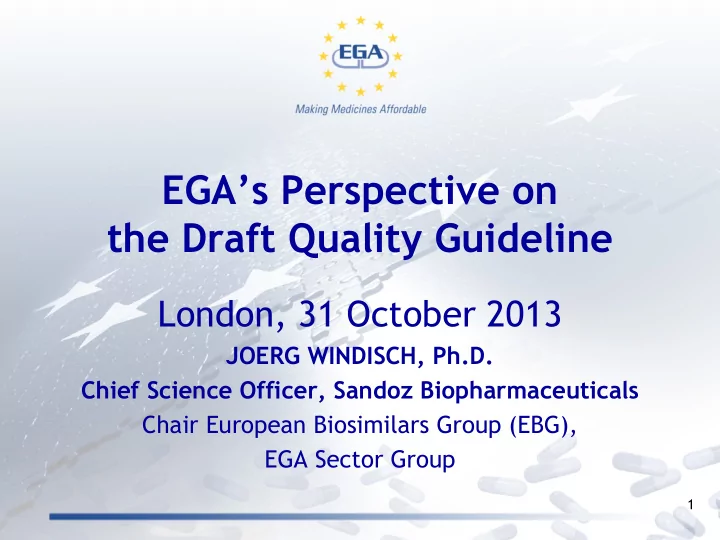

EGA’s Perspective on the Draft Quality Guideline London, 31 October 2013 JOERG WINDISCH, Ph.D. Chief Science Officer, Sandoz Biopharmaceuticals Chair European Biosimilars Group (EBG), EGA Sector Group 1
Introduction Many thanks for an excellent, science- based guideline! Overview: 1.Quality target product profile 2.Different/novel expression systems 2
Biologics are understood extremely well today Primary structure e.g.: Higher order structure e.g.: •LC-MS intact mass •NMR •LC-MS subunits •CD spectroscopy •Peptide mapping •FT-IR Impurities e.g.: •CEX, cIEF acidic/basic variants •LC glycation Post translational modifications e.g.: •Peptide mapping deamidation, •NP-HPLC-(MS) N-glycans •oxidation, mutation, glycation •AEX N-glycans •SEC/FFF/AUC aggregation •MALDI-TOF N-glycans •HPAEC-PAD N-glycans Biological activity e.g.: •MALDI-TOF O-glycans •HPAEC-PAD sialic acids •Target binding •RP-HPLC sialic acids •Activity •F c receptor binging •ADCC •CDC Combination of attributes e.g.: •Apoptosis • In vitro immunogenicity •MVDA, mathematical algorithms Data integration provides more knowledge and certainty than the sum of the individual data 3
1. QTPP and similarity acceptance criteria Relevant factors: a)Variability observed in reference product defines the target for product development b)Criticality of attributes Clinical relevance impacts the similarity acceptance criteria 4
a) Variability of the reference product Batch-to-batch Biological Activity (Units/mg) • Non-identicality is a normal principle in glycosylated proteins • No batch of any biologic is “identical” to the other batches • Variability is natural even in the human body and usually not problematic Batch of drug substance (DS) Schneider, C. K.: Biosimilarity: A better definition of terms and concepts. 25th Annual DIA EuroMeeting , 04-06/03/2013, Amsterdam Manufacturing changes ADCC Potency Unfucosylated G0 140 2,0 Post- [% of reference] [% of glycans] Shift 1,6 120 Post- • Manufacturing changes are made 1,2 Shift Pre-Shift 100 frequently 0,8 80 • Differences in attributes often larger 0,4 Pre-Shift than batch-to-batch variability 60 0,0 08.2007 12.2008 05.2010 09.2011 08.2007 12.2008 05.2010 09.2011 • Such changes are stringently Expiry Date Expiry Date controlled by regulators and approved Schiestl, M., et al. : Acceptable Changes in Quality Attributes of Glycosylated Biopharmaceuticals. Nature Biotechnology , 29: 310-312, 2011 only if they do NOT lead to clinically meaningful differences 5
a) Variability of the reference product Batch-to-batch Biological Activity (Units/mg) • Non-identicality is a normal principle in glycosylated proteins • No batch of any biologic is “identical” to the other batches • Variability is natural even in the human Safety and efficacy within this variability body and usually not problematic Batch of drug substance (DS) Schneider, C. K.: Biosimilarity: A better definition of terms and have been demonstrated in clinical concepts. 25th Annual DIA EuroMeeting , 04-06/03/2013, Amsterdam studies and by real-life experience Manufacturing changes ADCC Potency Unfucosylated G0 140 2,0 Post- [% of reference] [% of glycans] Shift 1,6 with the reference product 120 Post- • Manufacturing changes are made 1,2 Shift Pre-Shift 100 frequently 0,8 80 • Differences in attributes often larger 0,4 Pre-Shift than batch-to-batch variability 60 0,0 08.2007 12.2008 05.2010 09.2011 08.2007 12.2008 05.2010 09.2011 • Such changes are stringently Expiry Date Expiry Date controlled by regulators and approved Schiestl, M., et al. : Acceptable Changes in Quality Attributes of Glycosylated Biopharmaceuticals. Nature Biotechnology , 29: 310-312, 2011 only if they do NOT lead to clinically meaningful differences 6
b) Clinical relevance (criticality) of the attribute 1/2 Systematic criticality assessment must be performed on all quality attributes Impact on safety and efficacy is what matters Much is known about the clinical relevance of the various quality attributes – Has been managed well after manufacturing changes – Structure-function relationships studied systematically – Much known from literature and previous experience 7
b) Clinical relevance (criticality) of the attribute 2/2 The culprits are well known, e.g. Sialylation PK Fucosylation ADCC Gal- 1,3-Gal immunogenicity Aggregates immunogenicity Criticality should be evaluated in a systematic and quantitative way 8
Acceptance criteria are based on RP variability AND clinical relevance Two elements impact acceptance criteria: Variability of reference product Clinical relevance of attribute Flexibility for attributes with no clinical impact is higher One-sided ranges for similarity exercise often appropriate (e.g. less aggregates acceptable) EMA may want to describe this risk-based approach in more detail in the guideline 9
2. Different/novel expression systems Different and novel are separate things Different expression systems that provide similar attributes and have equal or better safety track records Doable Novel expression systems that have NO safety track records Challenging 10
2. Different/novel expression systems: Examples “Doable”: CHO instead of SP2/0 Closely related systems (hamster, mouse) CHO has even better safety track record Provide similar attribute profiles, but CHO avoids some issues (e.g. Gal- 1,3-Gal) “Challenging”: Algae instead of CHO Very different systems Algae have no track record Provide very different attribute profiles 11
Summary The target for development is determined by the variability in the reference product The similarity acceptance criteria depend on the clinical relevance of the attributes in addition to RP variability Therefore, a purely statistical approach to setting acceptance criteria is insufficient If a different expression system is used, it must still yield a comparable CQA profile 12
Recommend
More recommend